|
McCloud Customers
McCloud Sawmill |
|
|
|
It would not be an understatement to say that the giant sawmill in McCloud, CA, provided the primary existence for the continued operations of the McCloud River Railroad through most of its history. Beginnings- Friday George Friday George built the first sawmill in what would become McCloud. Friday came to the area several years before as a Division Superintendent for the Southern Pacific Railroad. After losing that job he went into the lumber business, first by purchasing and re-opening a closed sawmill near Soda Creek, in the Sacramento River canyon south of Dunsmuir. The canyon limited the amount of timber available to his sawmill, however, and in May and June of 1892 he moved the sawmill to a new spot on the banks of Squaw Creek on the western edge of the broad McCloud River valley. George named the site Sugar Pine Park. This move solved the problem of timber supply, but it created another more serious problem- transportation. The sawmill now lay literally on the wrong side of the mountain from the railroad, which provided the only economical means to transport lumber to distant markets. Friday George initially tried to get the Southern Pacific to construct a branchline to his new sawmill, but the big railroad was not interested. George then went to his plan B, which involved constructing a new road from Sugar Pine Park westward over Snowman's Summit to the Southern Pacific in the area of Mott. In 1893 George purchased a new traction engine to help construct the road. By this point George had two log camps set up in the woods east of town to supply his sawmill with timber. His plans called for the traction engine to move the daily output of his sawmill- roughly 30,000 board feet- to the SP at Mott ever day, with every night spent bringing the logs from his two camps to the mill. However, once the traction engine went into operation it could only move 15,000-20,000 board feet of lumber each day as far as Snowman's Summit, with two trips to Camp 1 and one trip to Camp 2 to get logs filling out each 24-hour period. George had to use local teams to transport the lumber from Snowman's Hill down to Mott. By this point George had run well past the limits of his financing, and he found himself unable to cut and transport lumber fast enough to satsify his debts. A crash in the lumber market landed the final blow, and in October 1894 the company imploded. At the time of his failure George had assetts valued at $6,000 and liabilities amounting to $51,000. The McCloud River Lumber Company In the months after George's failure creditors gathered to pick apart what remained of his operation. The firt auctions in 1895 ended early due to unacceptably low bids. However, two businessmen named George Scott and William Van Arsdale were evaluating the property, and as 1895 rolled into 1896 they launched what would become one of the most successfull lumber operations in California history. Scott and Van Arsdale first met as students in the engineering program at University of California-Berkeley. The pair formed a business partnership, with their headquarters based in San Francisco. They then became involved in a series of businesses associated with the new Central Pacific line advancing around the base of Mt. Shasta. The Siskiyou Lumber & Mercantile Company was one of the companies the pair became involved in, first as managers and then as majority owners. SL&M owned at least five sawmills in the area in addition to a large retail store in Sisson and some other properties. In early 1896 Scott and Van Arsdale acquired the Friday George properties using the SL&M corporate umbrella. In March 1896 Scott, Van Arsdale, and some other associates incorporated the McCloud River Lumber Company to manage the old George properties. The new company immediately set out to build a new sawmill on the same site as George's mill. The company designated this facility as Mill #2. The new owners also decided that the sawmill needed a permanent community to attract and retain employees, and to that end the company purchased the homestead of Judge J.S. Beard, which lay immediately north of the sawmill site. Construction of the planned community started shortly afterwards, with the town named Vandale, a contraction of Van Ardale's last name. Mill #2 went into operation in 1897, whortly after the McCloud River Railroad completed its line from Upton to Vandale. The Vandale name proved to be short lived, however, as shortly after operations started the company changed the name of the town to McCloud. The first corporate change came in 1902 when a group of experienced Minnesota timber capitalists led by Judson Carpenter purchased control of the McCloud River Lumber Company from Scott and Van Arsdale. The new owners brought with them a large amount of available capital, which enabled them to make many improvements to the property. In 1903 the Ash Creek Sawmill, the other mill owned by the company (detailed separately), burned to the ground. The company elected to consolidate all sawmill operations into McCloud, and shortly after the Ash Creek Fire the company broke ground on an entirely new sawmill complex to the northwest of town. The company designated this facility as Mill #1. The two sawmills in McCloud kept the railroad very busy, both in hauling raw logs from the woods to the mill and in hauling finished lumber to the Southern Pacific interchange. Mill #2 served the company well until the late 1910's, when time and technology finally passed it by. In 1919 the lumber company completed a second new sawmill directly adjacent to Mill #1, and Mill #2 closed shortly afterwards. The company demolished most of the buildings at the Mill #2 site, with only the concrete mill footings remaining to show where the original facilities stood. The McCloud sawmill prospered through the years, with the facilities expanded to include a box factory, a planing mill, and many smaller support facilities. An extensive in-plant narrow gauge switching railroad connected all the various parts of the plant together, with motive power provided by horses in the early years. A handfull of small switchers replaced the horses starting in the mid-1920's. The plant also featured a large log pond on the north side of the complex. The McCloud River Lumber Company sawmill cut an average of over a half million board feet each day, which consistently placed it as the second largest sawmill anywhere in the state of California. The sawmill alone employed roughly 1,000 people through most of this era. The sawmill remained as the largest single shipper on the McCloud River Railroad, with both the inbound log carloads from the woods and the outbound finished products providing very good business to the railroad. The era closed in 1963. The timber industry had been in a period of consolidation for several years by this point, and the McCloud River Lumber Company stood out as far too good of an acquisition target to pass up. The summer of 1963 saw the stockholders voting on a $40 million offer from U.S. Plywood, a vote that fell largely in favor of the buyout. The sale became official on 20 September 1963. U.S. Plywood/Champion International U.S. Plywood shattered life as it had existed in McCloud. The McCloud River Lumber Company had long been close to its employees, and to many the passing of the company felt like a death in the family. U.S. Plywood did its best to assure the employees of their intent to stay for the long term, but the family like atmosphere that prevailed in McCloud before the merger disappeared. U.S. Plywood made several changes in the early months of its ownership that had a dramatic effect on the community and the railroad. The biggest changes involved closing both of the remaining logging camps, Pondosa and Kinyon, with all employees transferred to McCloud. The new owners also ended the logging railroad era, with all log movements from the woods to the mill handled by trucks. In 1965 U.S. Plywood ended the company town era by selling off all assetts outside the sawmill to John W. Galbreath & Company, a firm that specialized in the privatization of company towns. The new owners made a few changes to the physical plant through their ownership. The company built a large warehouse addition onto the back of one of the railroad's old shop buildings, which created another place to store lumber and load railcars. U.S. Plywood also filled in the old log pond, with all logs subsequently dry decked until ready to go into the sawmill. U.S. Plywood continued logging primarily with its own crews, with a large fleet of log trucks used to bring the logs in from the woods. U.S. Plywood survived until 1967, when it merged with Champion Papers, Inc. to form U.S. Plywood-Champion Papers, Inc. Most people shortened this to "Ply-Champ". This corporation eventually evolved into Champion International Corporation. Even without the inbound log traffic the sawmill continued to be the largest shipper on the railroad and the primary reason for McCloud's continued existence, even though the company no longer owned the town. The tough economic times of the late 1970's coupled with increasing environmental regulations finally caught up with Champion International. In 1979 the company closed the McCloud mill, which sent the town and the railroad into an economic tailspin. Champion International sold the sawmill properties, but retained ownership of the timberlands until financial giant John Hancock purchased them in the mid-1980's. P&M Cedar Products/Cal Cedar Shortly after Champion International closed the McCloud mill it sold the property to P&M Cedar Products, a medium sized company that specialized in producing cedar pencil stock. The company re-built and re-tooled the old sawmill facilities, with the plant re-opening in 1980. P&M turned the old sawmill into a state of the art computerized facility that employed only a fraction of the workforce Champion International had. The new owners abandoned the old planing mill and box factory buildings on the western edge of the complex, with a new rail spur built from the yard up to the remaining facilities. However, the sawmill relied on trucks for most of its transportation needs, with only a very small percentage of its output shipped by rail. In the mid-1980's shipments over the railroad did improve somewhat when P&M started shipping carloads of unfinished products between the McCloud mill and another plant the company owned in Mt. Shasta City. However, this movement did not last long, as the company closed the Mt. Shasta plant in the late 1980's. P&M Cedar Products remained in operation into the early 2000's before a re-organization brought a new name, Cal Cedar. Cal Cedar brought no changes to the plant except for the name; however, Cal Cedar's operations would prove to be short lived. The decline of the wooden pencil spelled trouble for the company, and the ax finally fell at the end of May 2003. Cal Cedar closed the mill and laid off all employees. The sawmill was the last remaining example of the once mighty sawmill industry in Siskiyou County when it closed. The sawmill buildings have stood empty since the closure, with only a small security staff on hand to patrol the complex. Nestle Waters purchased the sawmill complex in July 2004, with plans to tear down the buildings and construct a large water bottling facility in their place. The water plant still faces many legal and political obstacles before it becomes a reality; meanwhile, the buildings continue to sit, awaiting their fate.
|
|
|
Photos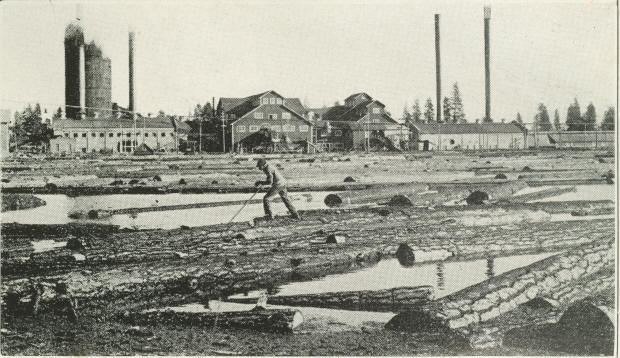 |
|
The large double sawmills of the McCloud River Lumber Company. Photo is from a 1932 date book produced by the lumber company. |
|
|
In July 1995 Lee Christopher gained permission to tour the various McCloud
shippers active at the time. He took many photographs, mostly to assist him with creating his
fine McCloud Railway layout. The pictures he took of the sawmill- then operated by P&M Cedar-
are displayed below.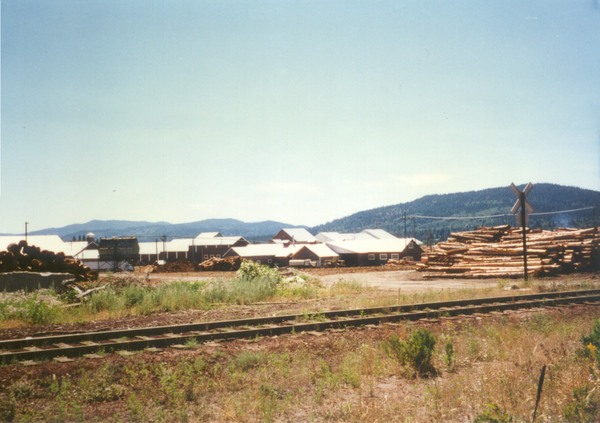 |
|
The north side of the P&M Cedar Products mill, looking into the plant across the McCloud Railway mainline. |
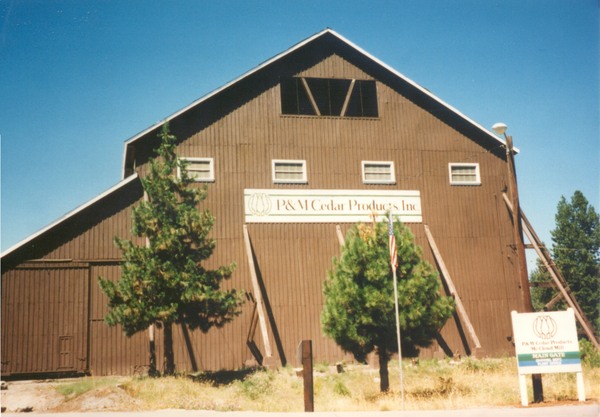 |
|
The company name on the end of the crane shed. |
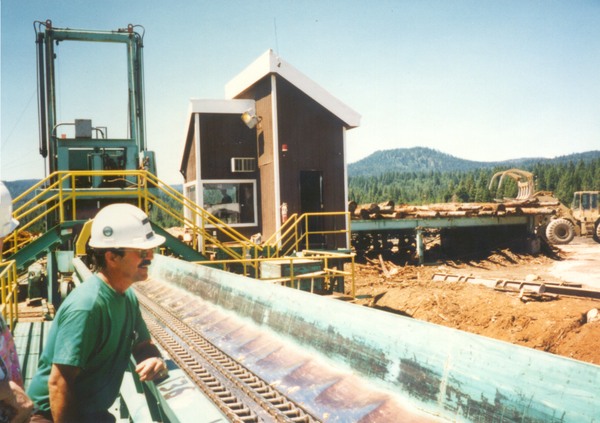 |
|
A loader placing logs onto the conveyor that carries logs into the plant. |
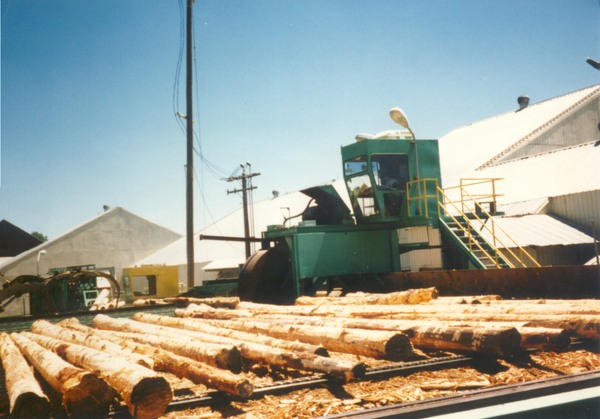 |
|
A close up shot of the logs on the conveyor on their way into the mill. |
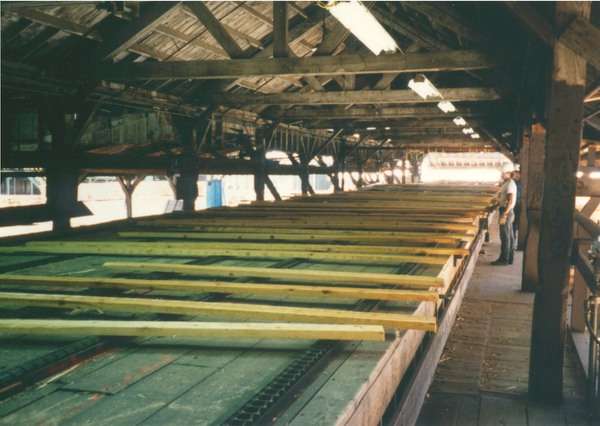 |
|
The green chain, where fresh cut lumber is sorted and graded. |
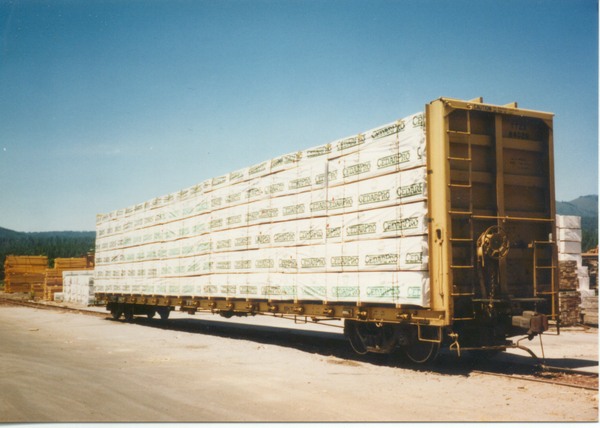 |
|
Most of the output of the P&M plant left on trucks, with only about two dozen railcars shipped out over the railroad each year. Here is one of the rare loads ready to go. |
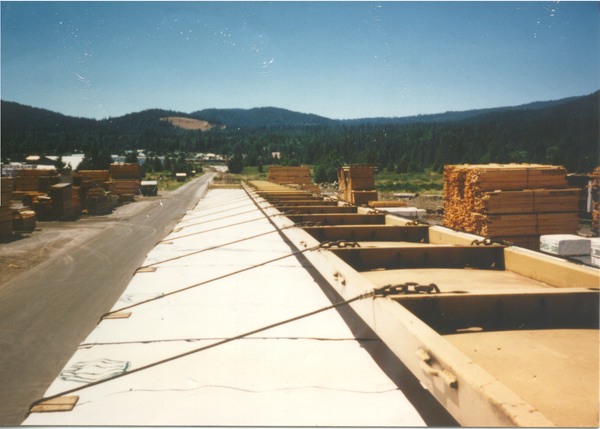 |
|
The top of the wrapped lumber load. |
|
|